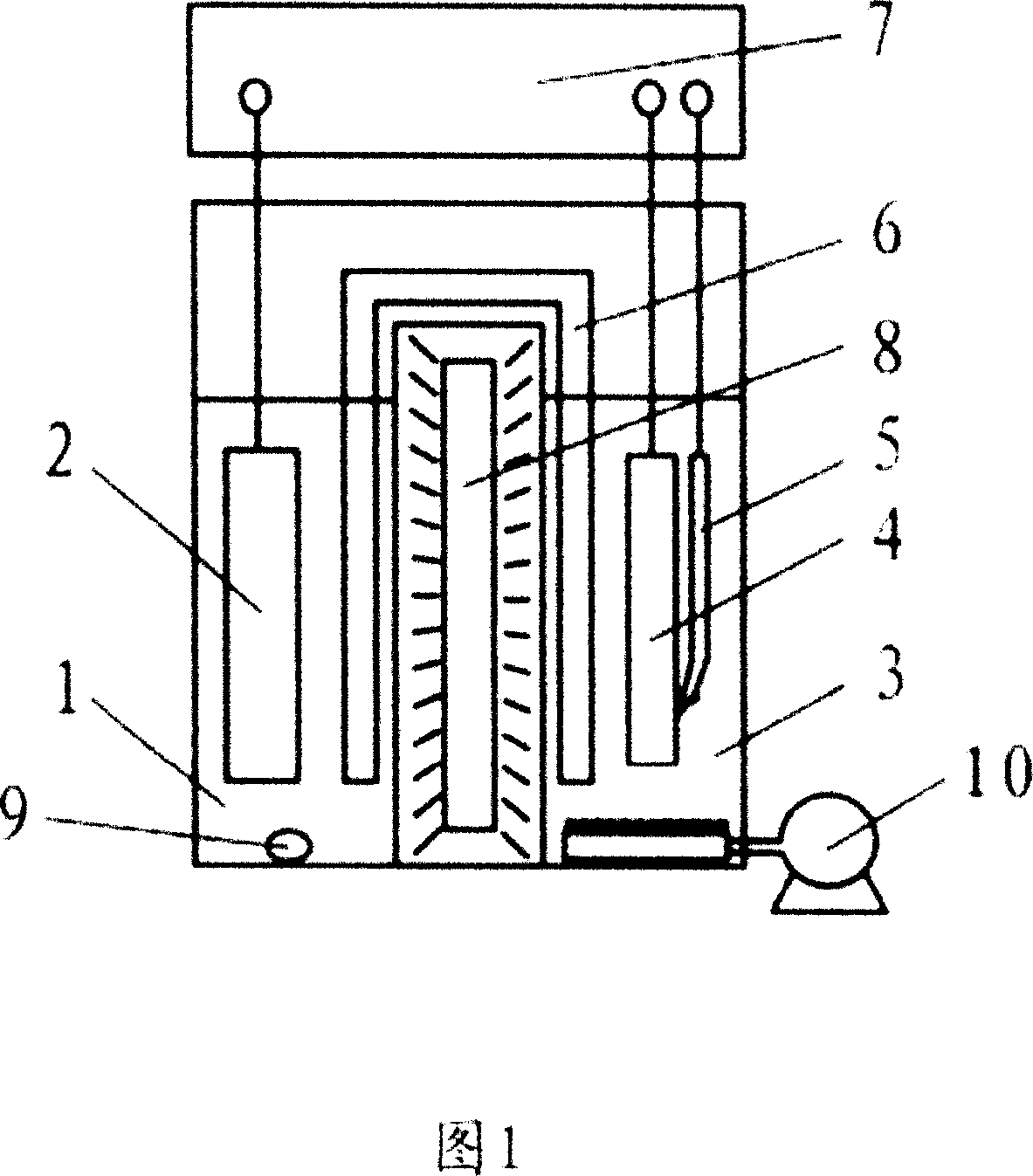Photoelectrical chemical synergistic catalytic reaction waste water treatment method and device
A photoelectrochemical and synergistic catalysis technology, applied in electrochemical water/sewage treatment, oxidized water/sewage treatment, illuminated water/sewage treatment, etc., can solve problems such as strong pH dependence, achieve universal applicability, and improve catalytic degradation. efficiency, the effect of improving the degradation efficiency
- Summary
- Abstract
- Description
- Claims
- Application Information
AI Technical Summary
Problems solved by technology
Method used
Image
Examples
Embodiment 1
[0021] As shown in Figure 1, wastewater treatment device of the present invention is made of anode tank 1, anode 2, cathode tank 3, cathode 4, reference electrode 5, salt bridge 6, potentiostat 7, high pressure mercury lamp 8, stirrer 9, Air pump 10 etc. are formed. The cathode 4 is a graphite electrode, and the anode 2 is TiO based on Ti 2 Thin-film electrodes, the reference electrode 5 is a calomel electrode, the three electrodes 2, 4, 5 are connected with the potentiostat 7, and the two-pole tanks 1, 3 are connected by a salt bridge 6. A high-pressure mercury lamp 8 is housed between the two pole grooves 1,3, which can irradiate the cathode and anode poles 2,4 at the same time. At the bottom of the anode tank 1, a magnetic stirrer 9 is installed. Outside the cathode tank 3, an air pump 10 is provided, and the exhaust pipe of the air pump 10 extends into the cathode tank 3.
[0022] In the above-mentioned device, the inventors carried out catalytic oxidation degradation t...
Embodiment 2
[0024] The device is the same as in Example 1.
[0025] When using the device of the present invention to treat the waste water containing reactive brilliant red X-3B pollutants with chromaticity of 300 degrees, when the cathode potential is Ec=-0.6V, the initial pH of the solution in the cathode tank=3.0~5.0, in the anode tank When the pH of the wastewater is not adjusted, the catalytic oxidation reaction is 60min, and the degradation and decolorization rates of 200mL of wastewater in the cathode tank and the anode tank can respectively reach 99.5% and 83.8%. with only TiO 2 Compared with the catalytic degradation rate of 200mL waste water in the anode tank by the / Ti film anode (that is, photoelectric catalysis) to 78%, the catalytic oxidation degradation efficiency of the present invention to organic matter is significantly improved.
Embodiment 3
[0027] The device is the same as in Example 1.
[0028] When using the device of the present invention to treat wastewater containing aniline concentration of 50mg / L, when the cathode potential is Ec=-0.6V, the initial pH of the solution in the cathode tank=3.0~5.0, and when the pH of the wastewater in the anode tank is not adjusted, the catalytic The oxidation reaction takes 60 minutes, and the degradation rates of 200mL of wastewater in the cathode tank and the anode tank can respectively reach 96.5% and 74.5%. with only TiO 2 Compared with the catalytic degradation rate of 200mL waste water in the anode tank by the / Ti thin film anode (that is, photoelectric catalysis) to 70.5%, the catalytic oxidation degradation efficiency of the present invention to the organic matter is significantly improved.
PUM
 Login to View More
Login to View More Abstract
Description
Claims
Application Information
 Login to View More
Login to View More - R&D
- Intellectual Property
- Life Sciences
- Materials
- Tech Scout
- Unparalleled Data Quality
- Higher Quality Content
- 60% Fewer Hallucinations
Browse by: Latest US Patents, China's latest patents, Technical Efficacy Thesaurus, Application Domain, Technology Topic, Popular Technical Reports.
© 2025 PatSnap. All rights reserved.Legal|Privacy policy|Modern Slavery Act Transparency Statement|Sitemap|About US| Contact US: help@patsnap.com

